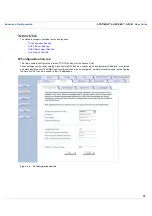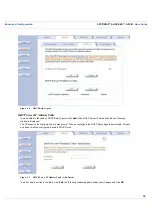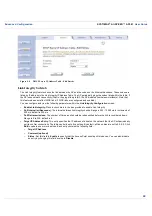
User Guide
Advanced Configuration
SYSTIMAX
AirSPEED
AP541
User Guide
42
Operational Mode
You can configure and view the operational mode for the Wireless Interface::
•
Operational Mode: the mode of communication between the wireless clients and the Access Point:
•
802.11b only
•
802.11g only
•
802.11b/g
•
802.11a only
Super Mode and Turbo Mode
Super mode improves throughput between the Access Point and wireless clients that support this capability. For
wireless clients that support this capability the AP will negotiate and treat them accordingly, for other clients that do not
support super mode, the AP will treat them as normal wireless clients.
Super Mode can be configured only when the wireless operational mode is one of the following:
•
802.11g only mode
•
802.11b/g mode
•
802.11a only mode
Dynamic Turbo mode is supported in 802.11a and 802.11g mode. Dynamic turbo mode support turbo speeds at twice
the standard 802.11a or 802.11g data rates, and also dynamically switches between turbo mode speeds and normal
speeds depending on the wireless client. If turbo mode is enabled, then this is displayed in the web UI and the transmit
speeds and channels pull-down menus are updated with the valid values.
When Turbo mode is enabled, only a subset of the wireless channels on both the 2.4 GHz and 5.0 GHz spectrum can
be used.
Turbo mode can be configured only when Super Mode has already been enabled.
The Super 802.11g mode, Super 802.11a mode, and Turbo 802.11g mode are supported in all regulatory domains.
However, Turbo 802.11a mode is not available in the Japan regulatory domain.
IEEE 802.11D Support for Additional Regulatory Domains
The IEEE 802.11d specification allows conforming equipment to operate in more than one regulatory domain over
time. IEEE 802.11d support allows the AP to broadcast its radio’s regulatory domain information in its beacon and
probe responses to clients. This allows clients to passively learn what country they are in and only transmit in the
allowable spectrum. When a client enters a regulatory domain, it passively scans to learn at least one valid channel,
i.e., a channel upon which it detects IEEE Standard 802.11 frames.
The beacon frame contains information on the country code, the maximum allowable transmit power, and the channels
to be used for the regulatory domain.
The same information is transmitted in probe response frames in response to a client’s probe requests. Once the client
has acquired the information required to meet the transmit requirements of the regulatory domain, it configures itself
for operation in the regulatory domain.
The radio determines the regulatory domain the AP is operating in. Depending on the regulatory domain, a default
country code is chosen that is transmitted in the beacon and probe response frames.
Configuring 802.11d Support
Perform the following procedure to enable 802.11d support, and select the country code:
1. Click Configure > Interfaces > Operational Mode.
2. Select Enable 802.11d.
3. Select the Country Code from the ISO/IEC 3166-1 CountryCode drop-down menu.
4. Click OK.
5. Configure Transmit Power Control and transmit power level if required.
Содержание SYSTIMAX AirSPEED AP541
Страница 1: ......
Страница 11: ...Contents SYSTIMAX AirSPEED AP541 User Guide 11 802 11a 201 802 11g 202 ...























